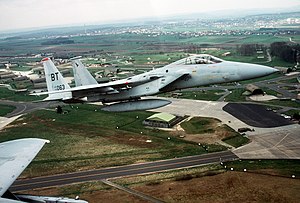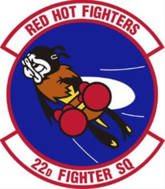22nd Fighter Squadron
| 22nd Fighter Squadron | |
|---|---|
 22nd Fighter Squadron - McDonnell Douglas F-15C Eagle 79-0063 | |
| Active | 1940–1946; 1946–2010 |
| Country | |
| Branch | |
| Role | Fighter |
| Motto(s) | Red Hot Fighters |
| Engagements |
|
| Decorations |
|
| Commanders | |
| Notable commanders | William R. Looney III "Toons"; Edwin Buzz Aldrin "Buzz"; James F. "Nails" Knight |
| Insignia | |
| 22nd Fighter Squadron emblem (approved 27 June 1945)[1] |  |
The 22nd Fighter Squadron, sometimes written as 22d Fighter Squadron, (22 FS) is an inactive United States Air Force unit. It was last assigned to the 52nd Operations Group and stationed at Spangdahlem Air Base, Germany.
Originally constituted as the 22nd Pursuit Squadron (Interceptor) in 1939, it first deployed to the Caribbean before deploying to England and Europe from 1944. After
History
World War II
Antilles Air Command
The 22d Pursuit Squadron (Interceptor) was constituted on 22 December 1939, and activated in February 1940 at
After its arrival at Ponce, the Squadron converted from the P-36A to
Operations during most of the remainder of 1942 are vague, but involved very extensive over-water flying and many scrambles in response to reported
With the Navy taking over the antisubmarine mission, the squadron was redeployed back to the United States, moving to Morrison Field, Florida by 27 May 1943.
Ninth Air Force

Transferred to
On
Participated in the
By

Reactivated in October 1946 under
As a result of the


Bitburg Air Base
In August 1953, the
In May 1961, received the
The squadron was upgraded to the



Operations Desert Shield/Desert Storm
After the
Operation Provide Comfort
The end of Operation Desert Storm marked the beginning of Operation Provide Comfort and once again the 36th Tactical Fighter Wing, including the 22nd, was tasked with providing aircraft and personnel in support of Operation Provide Comfort and later Operation Provide Comfort II. This included enforcement of the northern and southern Iraqi no-fly zones and protection of Kurds in the northern region. While still deployed to Al Kharj, F-15C tail number 84-0014, an aircraft belonging to the 53rd TFS, but flown by 22nd pilot John "Nigel" Doneski, downed an Su-22 in violation of the southern no-fly zone.[6] In 1993, long after the squadron had been re-united in the middle of 1991, the 22nd returned to Incirlick as part of its ongoing commitment to Operation Provide Comfort II.
Spangdahlem Air Base
In the spring of 1994, as a result of the military post-Cold War draw down worldwide, the decision was made to close the operations portion of Bitburg Air Base and to send the squadron's F-15C/Ds and some of its personnel to RAF Lakenheath, England. Other personnel were absorbed by the 53rd Fighter Squadron ("Tactical" had been removed in the new post-Cold War era), which was moving to Spangdahlem, or assigned to other F-15 squadrons worldwide. However, the squadron's colors were transferred to Spangdahlem Air Base, Germany, on 1 April 1994. Once at Spandahlem, the 480th Fighter Squadron's colors were retired and the 22d's were assumed. The 22d then took on the mission, personnel and aircraft of the former 480th which flew the Block 50 F-16CJ, the Air Force's latest version of the Fighting Falcon. In 1998, the 22d transitioned from a primary general-purpose air interdiction squadron to its new primary mission as a Wild Weasel unit performing suppression of enemy air defenses. The squadron's most current version of the F-16 was outfitted with the high-speed anti-radiation missiles (HARM), GPS guided-inertial aided munitions, and the HARM targeting system.[3]

Peacekeeping operations
The 22d was quickly put into combat with its new capability when it deployed to
In December 2000 to March 2001, the squadron was assigned to Air Expeditionary Force 9. It regularly flew combat missions in support of Operations Northern and Operation Southern Watch.[3]
Operation Enduring Freedom
In response to U.S. presidential directives, following the
Operation Iraqi Freedom
In January 2003, the squadron forward deployed as the 22d Expeditionary Fighter Squadron to

In April 2010 20 F-16Cs were flown from Spangdahlem to the 148th Fighter Wing of the Minnesota Air National Guard, one F-16 was transferred to Edwards Air Force Base, California. All aircraft were from the 22d Fighter Squadron.[7] As a result of the drawdown of F-16s, the 22d and 23rd Fighter Squadrons were inactivated on 13 August 2010 and formed the a single "new" squadron, the 480th Fighter Squadron.[8]
Lineage
- Constituted as the 22nd Pursuit Squadron (Interceptor) on 22 December 1939
- Activated on 1 February 1940
- Redesignated 22nd Fighter Squadron on 15 May 1942
- Redesignated 22nd Fighter Squadron, Single Engine on 20 August 1943
- Inactivated on 31 March 1946
- Activated on 15 October 1946
- Redesignated 22nd Fighter Squadron, Jet Propelled on 27 October 1947
- Redesignated 22nd Fighter Squadron, Jet on 17 June 1948
- Redesignated 22nd Fighter-Bomber Squadron on 20 January 1950
- Redesignated 22nd Fighter-Day Squadron on 9 August 1954
- Redesignated 22nd Tactical Fighter Squadron on 8 July 1958
- Redesignated 22nd Fighter Squadron on 1 October 1991
- Inactivated on 13 August 2010[1]
Assignments
- 36th Pursuit Group(later 36th Fighter Group), 1 February 1940 – 31 March 1946
- 36th Fighter Group (later 36th Fighter-Bomber Group 36th Fighter-Day Group), 15 October 1946 (attached to 36th Fighter-Day Wingafter 1 October 1956)
- 36th Fighter-Day Wing (later 36th Tactical Fighter Wing, 36th Fighter Wing), 8 December 1957
- 36th Operations Group, 31 March 1992
- 52d Operations Group, 1 April 1994 – 13 August 2010[1]
Stations
|
|
Aircraft
|
|
References
- Notes
- POW. During the Korean War, Loring was posthumously awarded the Medal of Honor.
- ^ Aircraft is Lockheed P-80B-1-LO Shooting Star serial 45-8634 Taken in summer 1948. Aircraft markings appear to be those of Caribbean Air Command, no Buzz Number on fuselage.
- ^ Aircraft is Republic F-84E-10-RE Thunderjet serial 49-2223.
- ^ Aircraft is Republic F-105D-10-RE Thunderchief serial 60-438.
- Notes
- ^ a b c d e f g Dollman, TSG David (15 May 2017). "Factsheet 22 Fighter Squadron (USAFE)". Air Force Historical Research Agency. Retrieved 8 June 2017.
- ^ Collins, S. "Artful Patriotism: DOD and Disney". defense.gov. Retrieved 8 March 2020.
- ^ a b c d e f g "22 FS Fact Sheet". Archived from the original on 3 August 2008. Retrieved 16 April 2008.
- ^ "22nd Fighter Squadron". Skytrailer.com. 19 February 2016. Retrieved 27 September 2018.
- ^ "F-15 Multi-Stage Improvement Program". www.joebaugher.com. Retrieved 25 September 2018.
- ^ "Coalition Air-to-Air Victories in Desert Storm". www.rjlee.org. Retrieved 25 September 2018.
- ^ Gradishar, SRA Kali L. (26 April 2010). "F-16 drawdown to begin". 52d Fighter Wing Public Affairs. Archived from the original on 3 March 2016. Retrieved 8 June 2017.
- ^ Polesnak, 1 Lt Kathleen (24 August 2010). "480th activated as Spangdahlem's newest F-16 squadron". 52d Fighter Wing Public Affairs. Archived from the original on 4 February 2016. Retrieved 8 June 2017.
{{cite web}}: CS1 maint: numeric names: authors list (link) - ^ Station number in Anderson.
- ^ a b c d e f g h Station number in Johnson.
Bibliography
![]() This article incorporates public domain material from the Air Force Historical Research Agency
This article incorporates public domain material from the Air Force Historical Research Agency
- Anderson, Capt. Barry (1985). Army Air Forces Stations: A Guide to the Stations Where U.S. Army Air Forces Personnel Served in the United Kingdom During World War II (PDF). Maxwell AFB, AL: Research Division, USAF Historical Research Center. Archived from the original (PDF) on 23 January 2016. Retrieved 7 July 2012.
- Johnson, 1st Lt. David C. (1988). U.S. Army Air Forces Continental Airfields (ETO) D-Day to V-E Day (PDF). Maxwell AFB, AL: Research Division, USAF Historical Research Center. Archived from the original (PDF) on 29 September 2015.
{{cite book}}: CS1 maint: numeric names: authors list (link) - Maurer, Maurer, ed. (1983) [1961]. Air Force Combat Units of World War II (PDF) (reprint ed.). Washington, DC: Office of Air Force History. LCCN 61060979. Retrieved 17 December 2016.
- Maurer, Maurer, ed. (1982) [1969]. Combat Squadrons of the Air Force, World War II (PDF) (reprint ed.). Washington, DC: Office of Air Force History. OCLC 72556. Retrieved 17 December 2016.
- Ravenstein, Charles A. (1984). Air Force Combat Wings, Lineage & Honors Histories 1947-1977. Washington, DC: Office of Air Force History. ISBN 0-912799-12-9. Retrieved 17 December 2016.


